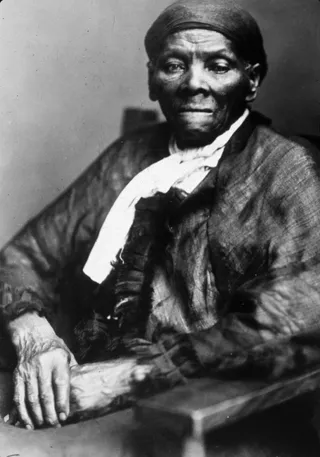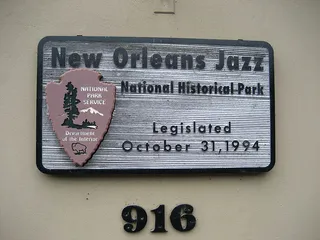A Tour of Black History Monuments Around the U.S.
Plan a visit to these historic sites.

1 / 26
Charles Young Buffalo Soldiers National Monument - As part of the American Antiquities Act, President Obama will announce on Monday two new national historical landmarks, the Charles Young Buffalo Soldiers National Monument in Ohio and the Harriet Tubman Underground Railroad National Monument in Maryland. The additions are among the dozens of landmarks honoring African-Americans located around the country. Keep reading to see some notable locations you can visit. -- Britt Middleton Located in Wilberforce, Ohio, the Col. Charles Young Buffalo Soldiers National Monument preserves the home of Col. Young, a distinguished officer in the United States Army who led an African-American regiment of soldiers that patrolled California's Sequoia National Park in 1903. (Photo: WikiCommons)

2 / 26
Harriet Tubman Underground Railroad National Monument - The new national monument gives visitors insight into Harriet Tubman's life as a slave as well as conductor on the Underground Railroad. Located on Maryland's Eastern Shore, the site includes Stewart’s Canal, dug by hand by free and enslaved people between 1810 and the 1830s and where Tubman learned important outdoor skills that would help her guide enslaved people to freedom. (Photo: MPI/Getty Images)
Photo By MPI/Getty Images

3 / 26
Booker T. Washington National Monument - This monument preserves the 207-acre farm in Franklin County, Virginia, where abolitionist and educator Booker T. Washington was born a slave on April 5, 1856. Washington was one of the most prominent Black leaders of the 18th and 19th century, and founded the Tuskegee Normal and Industrial Institute, presently Tuskegee University, in Alabama, in 1881. (Photo: Carol M. Highsmith/Buyenlarge/Getty Images)

4 / 26
African Burial Ground Monument - Between 1690 and 1794, an estimated 400 free and enslaved Africans were laid to rest in a 6.6-acre burial ground in what is present-day downtown Manhattan. The monument is located on the first floor of the Ted Weiss Federal Building. (Photo: WikiCommons)

5 / 26
George Washington Carver National Monument - This historic site in Diamond, Missouri, was the boyhood home of scientist and educator George Washington Carver. There in the wilderness, Carver was exposed to some of his earliest scientific observations, which would later inspire his groundbreaking research into the cultivation of sweet potatoes, peanuts and soybeans. The site includes the “Carver Trail,” a one mile loop that passes woodlands, streams and grass prairies. (Photo: Courtesy of The National Parks Service)
ADVERTISEMENT

6 / 26
Fort Monroe National Monument - Following the War of 1812, the U.S. built a network for seacoast defense. Named after President James Monroe, Fort Monroe in Virginia was the first and largest of these forts. During the Civil War, it served as a haven for escaped slaves was one of the nation's first self-contained African American communities. (Photo: Ben Bloker USAF / MAI /Landov)

7 / 26
Boston African American National Historic Site - This historic site commemorates Boston's historic Beacon Hill neighborhood. In the 19th century, it was a vibrant abolitionist community where free Blacks and whites fought together against slavery and inequality. Among its residents was John S. Rock, the first African-American allowed to practice law in front of the Supreme Court in 1865. (Photo: Wikicommons)

8 / 26
Brown v. Board of Education National Historic Site - The former Monroe Elementary School in Topeka, Kansas, is now an interactive museum where visitors can get an intimate look at the history behind the U.S. Supreme Court's historic Brown vs. Board of Education case in 1954, where the high court ruled "separate but equal" facilities for Black and white students violated the 14th Amendment of the U.S. Constitution. (Photo: Wikicommons)

9 / 26
Cane River Creole National Historical Park - In colonial Louisiana, the term "creole" was used to describe descendants of people born in Louisiana during French and Spanish occupation and whose mixed racial heritage includes African, French, Spanish and Native American. This Derry, Louisiana, site preserves the rich nuances of the creole culture as well as tours of the Oakland and Magnolia Plantations. (Photo: Wikicommons)

10 / 26
Carter G. Woodson Home National Historic Site - The home of historian Carter G. Woodson in Washington, D.C., has been preserved to honor his contributions to preserve the history of African-Americans for generations to come. Regarded as the father of Black History, Woodson established "Black History Week" in 1926, which we now celebrate as Black History Month. (Photo: Wikicommons)
ADVERTISEMENT

11 / 26
Dayton Aviation Heritage National Historical Park - The Paul Laurence Dunbar State Memorial is one of five national historic landmarks preserved at this historic site located in Dayton, Ohio. The Dunbar house was the home of celebrated poet Paul Laurence Dunbar and was the first African-American home in America designated as a public museum in 1938. (Photo: Wikicommons)

12 / 26
Fort Davis National Historic Site - From 1854 until 1891, U.S. Army troops stationed at Fort Davis in Texas protected travelers on the San Antonio-El Paso Road en route to California. Under the Act of 1866, for the first time, African-American soldiers were allowed to serve in the peacetime army and those stationed at Fort Davis contributed to protecting this key post in Western Texas. (Photo: Wikicommons)

13 / 26
Fort Scott National Historic Site - During the Civil War, Native Americans and African-Americans were recruited in the Fort Scott area in Kansas to fight alongside the Union Army. The most notable was the 1st Kansas Colored Infantry, the first African-American regiment to face the Confederates in combat. (Photo: Wikicommons)

14 / 26
Frederick Douglass National Historic Site - Washington, D.C., is home to the last residence of abolitionist leader Frederick Douglass. (Photo: Wikicommons)

15 / 26
Harpers Ferry National Historical Park - Located in West Virginia, this landmark commemorates a number of groundbreaking moments in Black history: it was the site of a deadly revolt led by abolitionist John Brown in 1859; during the Civil War, Harpers Ferry was a place of refuge for escaped slaves; and it was the home of Storer College, where W.E.B. Du Bois and other African-American thought leaders convened for the Niagara Movement, the forerunner of the National Association for the Advancement of Colored People, in 1906. (Photo: Wikicommons)
ADVERTISEMENT

16 / 26
Little Rock Central High School National Historic Site - In 1957, in the face of angry detractors, nine Black students were the first to integrate the all-white Little Rock Central High School. Their actions would serve as the test of the Brown v. Board of Education ruling for years to come. Click here to learn more about the Little Rock Central High School National Historic Site. (Photo: Wikicommons)

17 / 26
Lincoln Memorial - This Washington, D.C., memorial pays tribute to Abraham Lincoln, America's 16th president. His landmark accomplishment was the issuance of the Emancipation Proclamation in 1863, which freed an estimated 4 million slaves during the Civil War. (Photo: Wikicommons)

18 / 26
Maggie L. Walker National Historic Site - Businesswoman Maggie L. Walker founded the St. Luke Penny Savings Bank in 1903, becoming the first African-American woman to charter a bank in the U.S. Her home in Richmond, Virginia, has been preserved to honor her contributions as a community organizer and civil rights advocate. (Photo: Wikicommons)

19 / 26
Martin Luther King Jr. Memorial - After years in the making, the Martin Luther King Jr. Memorial in Washington, D.C., was finally unveiled to the public on Oct. 16, 2011. "And so on this day, in which we celebrate a man and a movement that did so much for this country, let us draw strength from those earlier struggles," President Obama said at the public dedication ceremony, which drew a crowd of thousands. (Photo: AP Photo/Susan Walsh)

20 / 26
Martin Luther King Jr. National Historic Site - The Martin Luther King Jr. National Historic Site in Atlanta preserves King's birth home and gravesite as well as the Ebenezer Baptist Church, where the civil rights leader once preached. (Photo: Wikicommons)
ADVERTISEMENT

21 / 26
Mary McLeod Bethune Council House National Historic Site - This historic site was the last residence of educator Mary McLeod Bethune. Bethune was the founder of the National Council of Negro Women and the Bethune-Cookman College in Daytona Beach, Florida, and also served as an adviser to four U.S. presidents. (Photo: Wikicommons)

22 / 26
New Orleans Jazz National Historical Park - Visitors to this French Quarter site can take in live daily jazz performances and a unique history into the origins of jazz in the Big Easy. (Photo: Wikicommons)
Photo By Photo: Wikicommons

23 / 26
Port Chicago Naval Magazine National Memorial - On the evening of July 17, 1944, 320 U.S. naval officers were instantly killed when two ships being loaded with ammunition exploded, making up the worst home front disaster of World War II. Of the dead, 202 were African-American enlisted officers that were assigned the dangerous role of loading the ships. The memorial site is located in San Francisco. (Photo: Wikicommons)

24 / 26
Selma-to-Montgomery National Historic Trail - This historic trail commemorates the civil rights marches from Selma to Montgomery, Alabama, the first of three taking place on March 7, 1965. In an event known as "Bloody Sunday," demonstrators were brutalized by Alabama state troopers. On their third attempt, the demonstrators, led by Dr. King, peacefully passed into Montgomery, inspiring the passing of the Voting Rights Act on Aug. 6, 1965. (Photo: National Parks Service)

25 / 26
Tuskegee Institute National Historic Site - In the 1940s, the U.S. military launched a program at Alabama's Tuskegee Institute to train African-American pilots and support staff. This site honors the 15,000 men and women who participated in the "Tuskegee Experience," including the World War II pilots known as the Tuskegee Airmen. (Photo: Arthur P. Bedou/Robert Abbott Sengstacke/Getty Images)
